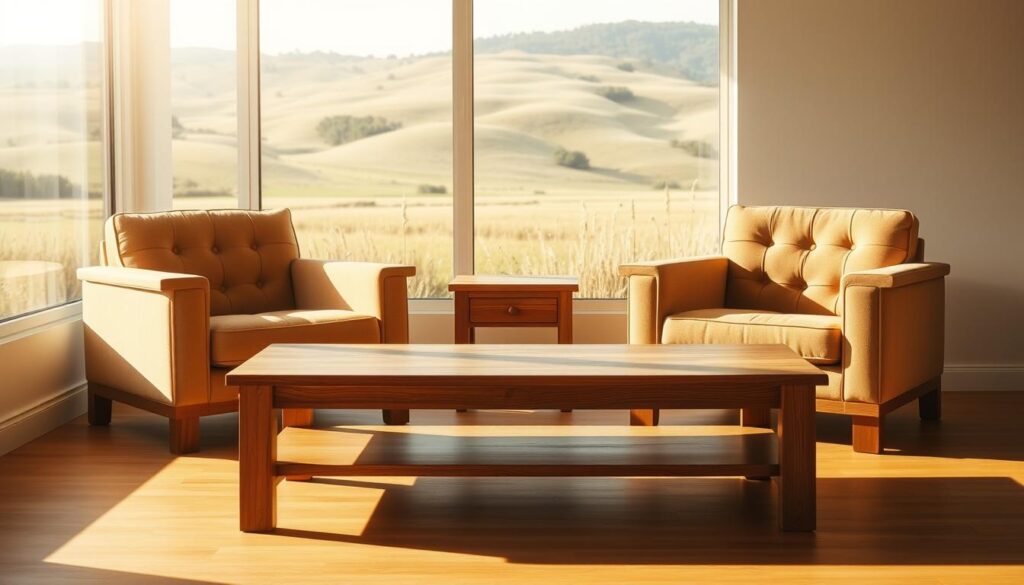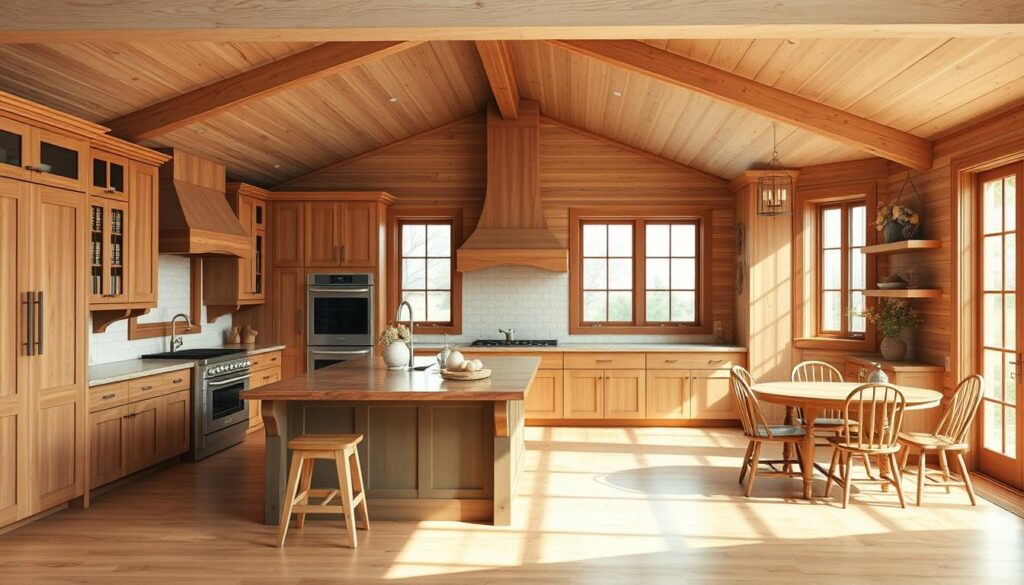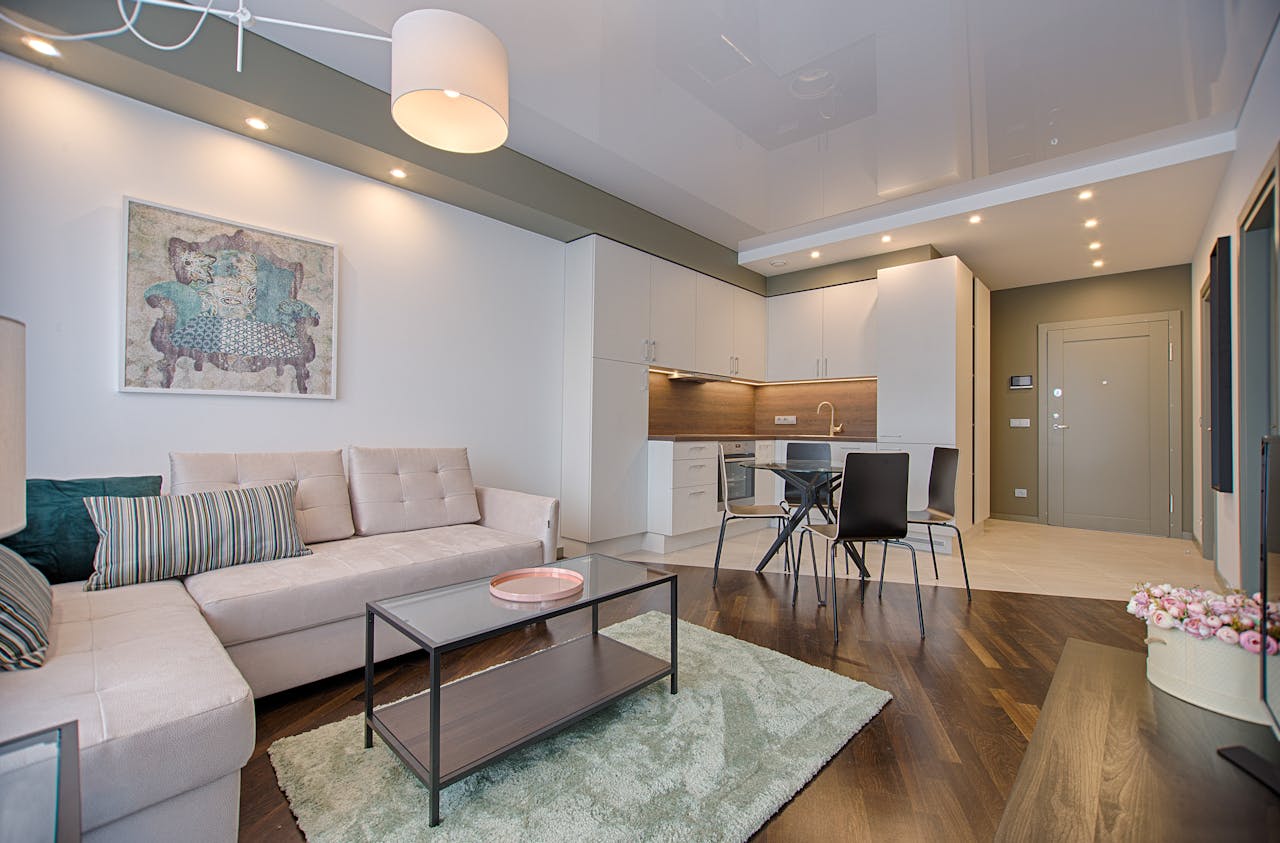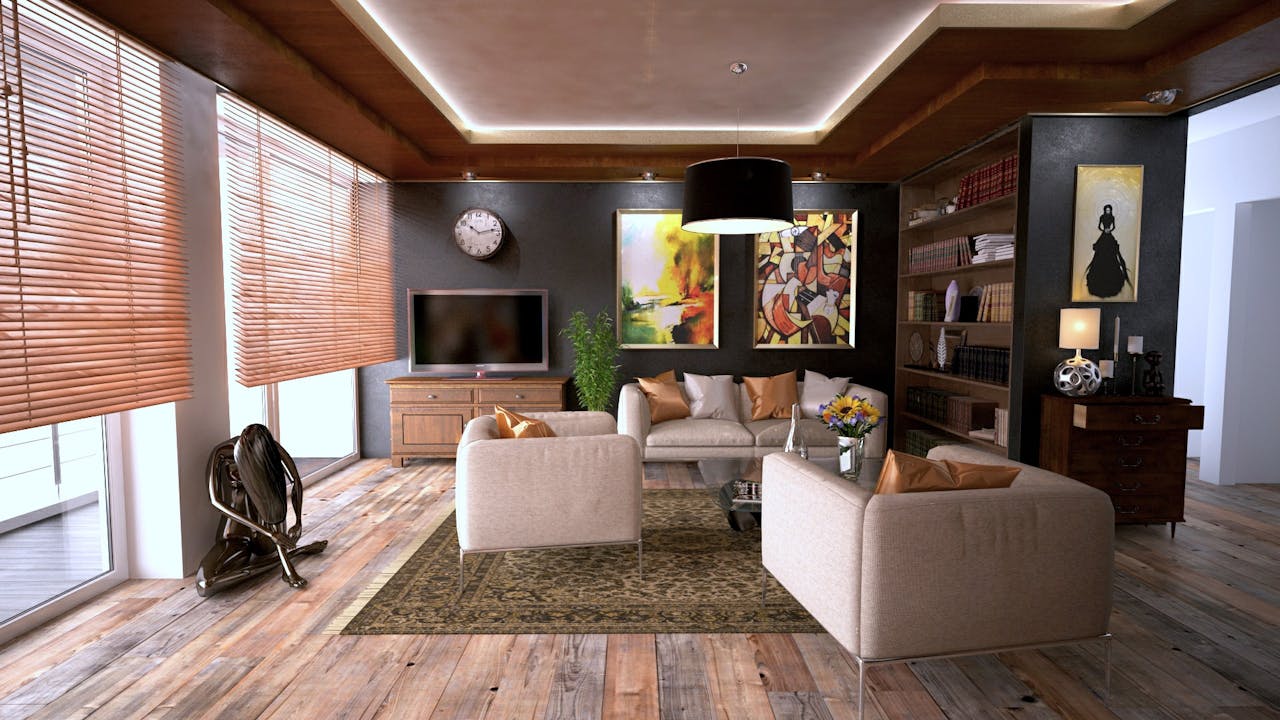Did you know that Prairie Style architecture has been a key part of American design since the early 1900s? It’s known for its clean lines, low-sloping roofs, and use of natural materials. This style creates a warm, inviting atmosphere that feels both timeless and elegant.
The secret to capturing the essence of Prairie Style is blending natural elements with simple decor. By connecting the indoors with the outdoors, we can make a cozy space. This honors the original Prairie School architects’ spirit.
Key Takeaways
- Emphasize natural materials in your decor
- Use clean lines and minimal ornamentation
- Incorporate elements that reflect the outdoors
- Opt for a low-profile, horizontal profile
- Balance warmth with elegance in your design choices
Understanding Prairie Style Interior Design
The Prairie Style, led by Frank Lloyd Wright, changed American architecture and interior design. It emerged in the early 20th century. It focused on connecting with nature and moving away from traditional designs.
Origin and Historical Context
Frank Lloyd Wright started the Prairie Style in the early 1900s. He wanted a distinctly American style that showed the wide open spaces of the prairies. This style was new, moving from Victorian-era homes to a minimalist, nature-focused design.
“The mother art is architecture. Without an architecture of our own, we have no soul of our own civilization.” – Frank Lloyd Wright
Wright’s designs were influenced by the Arts and Crafts movement. This movement valued handcrafted details and a connection to nature. Prairie Style homes blended into their surroundings, using natural materials and horizontal lines that matched the prairies.
Key Features of Prairie Style
Prairie Style interior design has several key features, including:
- Low-pitched roofs with long, horizontal lines
- Open floor plans that create a sense of spaciousness
- Emphasis on natural materials such as wood, stone, and brick
- Use of built-in cabinetry and furniture to create a cohesive look
- Integration with the natural surroundings through large windows and outdoor spaces
| Feature | Description |
|---|---|
| Low-Pitched Roofs | Reflects the flat landscape of the prairies |
| Open Floor Plans | Creates a sense of openness and spaciousness |
| Natural Materials | Wood, stone, and brick are commonly used |
Influential Designers
Frank Lloyd Wright was the most influential designer of the Prairie Style. Other architects like George Elmslie and George Maher also made important contributions. Their work made Prairie Style homes popular in the Midwest, mainly in Illinois and Wisconsin.
Today, modern Prairie Style still influences interior design. Many designers use elements of this classic style. The focus on natural materials, open spaces, and a connection to nature is still appealing for creating beautiful homes.
Elements of Prairie Style Homes
Prairie Style homes focus on horizontal lines, open spaces, and natural materials. This design movement started in the early 20th century. It aimed to create homes that blend with their surroundings.
Open Floor Plans
Open floor plans are a key feature of Prairie Style homes. They use fewer walls and partitions. This makes the homes feel spacious and free, allowing for better interaction between people.
These open plans also help merge indoor and outdoor living spaces. This is a core part of Prairie Style design. It makes the transition between indoors and outdoors smooth.
Horizontal Lines and Shapes
Horizontal lines and shapes are another key feature of Prairie Style homes. They help tie the home to the landscape, creating harmony. This design element also makes the home feel wide and expansive.
These lines remind us of the vast prairie landscapes that inspired this design.
Natural Materials
Prairie Style homes often use natural materials like wood, stone, and brick. These materials add warmth and texture to the interior. They make the home feel cozy and welcoming.
Using natural materials also strengthens the connection between the home and its surroundings. It helps blur the lines between indoors and outdoors.
Color Palettes for Prairie Style Interiors
In Prairie Style design, colors are more than just looks. They help create harmony with nature. The right colors bring together all design elements, making the space welcoming.
Earthy Tones
Earthy tones are key in Prairie Style color schemes. Shades like beige, brown, and green add warmth and coziness. They remind us of the prairies, bringing a sense of openness and connection.
To use earthy tones in your home, start with a neutral color for walls and furniture. Then, add depth with other earthy shades through accents and decor.
Accent Colors
Accent colors bring life and personality to Prairie Style homes. Blues and reds are popular choices, contrasting well with earthy tones.
Think about the mood you want to create with accent colors. Blues can be calming, while reds add energy.
| Color | Effect | Usage |
|---|---|---|
| Beige | Warmth, Neutrality | Walls, Furniture |
| Brown | Cozy, Earthy | Wood Accents, Furniture |
| Blue | Calming, Serene | Accent Walls, Decor |
| Red | Energetic, Vibrant | Accent Pieces, Artwork |
Incorporating Natural Light
Natural light is vital in Prairie Style homes. It enhances colors and makes spaces feel open. Large windows and skylights let in plenty of light.
To make the most of natural light, use sheer curtains or blinds. They let light in while keeping the outdoors view.
Furniture Selection in Prairie Style Homes
The furniture in Prairie Style homes is simple, functional, and connects to nature. It’s important to pick furniture that follows these principles.
Signature Furniture Pieces
Signature furniture in Prairie Style homes has clean lines and little decoration. Built-in cabinetry is a key feature, offering storage without closing off the space. Simple sofas and chairs, often in natural fabrics, are also typical.

Custom-Made Options
Custom furniture is a great choice for Prairie Style homes. It lets homeowners design pieces that fit their space perfectly. For example, custom cabinetry can be made to match the home’s design, adding both storage and style.
Functional Design
Functionality is crucial in Prairie Style furniture. Pieces are made to be both useful and stylish. A craftsman-style coffee table, for instance, brings warmth and character to a room while serving a practical purpose.
| Furniture Piece | Characteristics | Prairie Style Features |
|---|---|---|
| Built-in Cabinetry | Custom fit, storage | Clean lines, minimal ornamentation |
| Simple Sofas | Clean-lined, natural fabrics | Emphasis on horizontal lines |
| Craftsman-Style Coffee Table | Functional, warm materials | Use of natural materials, simple design |
Texture and Fabrics in Prairie Style
Prairie Style interiors focus on texture and fabrics for a cozy feel. They use natural materials and skilled craftsmanship. This makes the space welcoming and harmonious.
Natural Textiles
Wool, linen, and cotton are key in Prairie Style homes. They’re chosen for their natural look and lasting quality. This adds to the space’s warm and inviting vibe.
Frank Lloyd Wright’s textile designs show the Prairie Style’s love for natural beauty and handwork.
Layering Techniques
Layering textures and fabrics is crucial in Prairie Style design. It brings depth and interest to the space. Mixing smooth and rough textures, like linen and wool, creates a rich feel.
Using throw blankets, rugs, and pillows in natural materials helps achieve this layering. It makes the space engaging and inviting.
Patterns and Prints
Nature-inspired patterns and prints are key in Prairie Style decor. They include botanical motifs, geometric patterns, and organic forms. These add personality to the rooms.
By using these patterns in textiles, like printed fabrics or embroidered linens, we enhance the space’s look. It creates a cohesive, natural feel that reflects the Prairie Style’s connection to nature.
Choosing and combining natural textiles, layering, and nature-inspired patterns makes a Prairie Style interior beautiful and welcoming. This approach respects the traditional craftsmanship of the Prairie Style. It also makes the home warm and inviting.
Lighting Solutions for Prairie Style Interiors
Prairie Style homes focus on natural light to create a warm atmosphere. This style, known for openness and outdoor connection, uses lighting to show its beauty.
Importance of Natural Light
Natural light is key in Prairie Style interiors. Big windows and clerestory windows let in lots of light. This makes spaces feel open and airy.
This light also cuts down on the need for artificial light during the day. It also shows off the beauty of the outdoors.
Iconic Lighting Fixtures
Artificial lighting in Prairie Style homes is simple and doesn’t get in the way. Globe lights and pendant lights with clean lines are favorites. They provide focused light without taking away from the space’s details.
Creating Ambient Lighting
In the evening, ambient lighting makes spaces cozy. Table lamps, floor lamps, or string lights with warm shades are used. The aim is to keep the space warm and inviting, staying true to Prairie Style.
By choosing the right lighting, homeowners can make a space that celebrates natural light and simplicity. This creates a welcoming and harmonious living area.
Accessories and Decor in Prairie Style
To complete a Prairie Style home, choose accessories and decor that match its natural and simple look. These items should enhance the beauty of the interior.
Art and Wall Decor
Art and wall decor that show the natural world or simple shapes are good for Prairie Style homes. We can use pieces that remind us of nature. For example, handmade art pieces or natural fiber wall hangings can add a special touch.
Decorative Objects
Decorative objects from natural materials like wood, stone, or clay add warmth and character. They bring the outdoors inside. Think about using wooden decorative boxes or clay pottery to make the space feel more natural.
Incorporating Nature
Adding nature to Prairie Style decor can be done with plants, natural fibers, and organic shapes. This not only looks good but also connects us to the outdoors. For instance, adding indoor plants or using natural fiber rugs can really improve the space.
| Decor Element | Description | Example |
|---|---|---|
| Art and Wall Decor | Reflects natural world or simple geometric patterns | Handmade art pieces, natural fiber wall hangings |
| Decorative Objects | Made from natural materials | Wooden decorative boxes, clay pottery |
| Incorporating Nature | Use of plants, natural fibers, and organic shapes | Indoor plants, natural fiber rugs |
By carefully choosing accessories and decor, we can make Prairie Style homes more beautiful and welcoming. This creates spaces that are both elegant and inviting.
Kitchen Designs with Prairie Style Influence
Prairie Style kitchens are known for their openness and connection to living areas. They blend form and function beautifully. “The Prairie School style is not just about aesthetics; it’s about creating a harmonious living environment,” say architectural experts.

Open and Functional Layouts
Prairie Style kitchens are famous for their open layouts. This design removes barriers between the kitchen and other living spaces. It creates a sense of community and makes it easier to interact.
Key elements of open and functional layouts include:
- Minimal use of dividing walls or partitions
- Integration with dining and living areas
- Ample space for movement and workflow
Custom Cabinetry
Custom cabinetry is a key feature of Prairie Style kitchens. It shows off the style’s focus on craftsmanship. Cabinets have clean lines, little ornamentation, and use natural materials.
When selecting or designing custom cabinetry, consider the following:
- Material choices that reflect the Prairie Style’s emphasis on natural beauty
- Designs that incorporate horizontal lines and other characteristic Prairie Style elements
- Functionality that supports the kitchen’s workflow
Material Choices
The choice of materials in a Prairie Style kitchen is important. It shows the style’s love for natural beauty and durability. Common materials include wood, stone, and other natural finishes.
“The use of natural materials in Prairie Style kitchens not only adds warmth but also connects the indoor space with the outdoors.”
When picking materials for your Prairie Style kitchen, think about the color palette, texture, and aging. Aim to make a kitchen that’s beautiful, functional, and sustainable.
Bathroom Features in Prairie Style Homes
The bathroom in Prairie Style homes is a peaceful retreat. It combines simplicity with natural beauty. The design focuses on harmony with nature and clean lines.
Spa-Like Ambiance
Creating a spa-like feel is key in Prairie Style bathrooms. Natural materials like stone and wood are used. Large windows and greenery or river rocks bring the outdoors in.
Fixtures and Finishes
Fixtures and finishes in Prairie Style bathrooms are simple yet beautiful. Earth-toned ceramics and brushed metal fixtures in copper or bronze are popular. The look is clean and uncluttered, making the bathroom feel luxurious and calm.
Color Schemes
The colors in Prairie Style bathrooms are calming and muted. Shades of green, sandy neutrals, and sky blues remind us of the prairie. These colors create a peaceful atmosphere, turning the bathroom into a serene retreat.
Prairie Style bathrooms reflect the home’s design principles and offer a unique, refreshing space. Whether renovating or designing a new bathroom, embracing Prairie Style can create an exceptional space.
Landscape and Exterior Integration
The Prairie Style home design philosophy goes beyond the indoors. It sees the outdoors as a key part of our living space. This philosophy makes homes blend well with their surroundings, creating a perfect balance between built spaces and nature.
Indoor-Outdoor Flow
Prairie Style homes focus on connecting indoors and outdoors. They use big windows, sliding glass doors, and open floor plans. This makes the inside and outside feel like one, improving our living experience.
To make this connection even stronger, homeowners can add:
- Big decks and patios to expand outdoor living areas
- Garden rooms or sunrooms to bring the outdoors inside
- Landscaping that matches the home’s look and the natural setting
Landscaping Features
Landscaping is key in Prairie Style homes. It helps blend the home with its surroundings. Some common features include:
- Native plants that fit the local climate and soil
- Natural garden designs that look like the surrounding landscape
- Water features like ponds or fountains for visual interest and calm
Patio and Outdoor Living Spaces
Patio and outdoor living areas are vital in Prairie Style homes. They offer places to relax, entertain, and enjoy nature. These areas can be made functional and cozy, with features like:
- Outdoor kitchens and dining for al fresco meals
- Fire pits or outdoor fireplaces to enjoy longer outdoor seasons
- Comfortable seating and outdoor furniture that matches the home’s style
By adding these elements, homeowners can create a seamless indoor-outdoor living space. This reflects the Prairie Style home’s focus on living in harmony with nature.
Tips for Achieving Prairie Style
To bring the timeless elegance of Prairie Style into your home, we need to find a balance. We should mix traditional elements with modern sensibilities. This blend creates a harmonious space that feels both classic and contemporary.
Blending Classic and Contemporary
Combining traditional Prairie Style with modern touches is crucial. We can use clean lines, minimal ornamentation, and focus on horizontal planes. This approach helps achieve the unique Prairie Style aesthetic.
Adding Personal Touches
Adding meaningful objects and artwork makes the space truly yours. Personal touches help create a space that reflects our individuality. Yet, it still keeps the essence of Prairie Style.
Expert Guidance
Getting professional advice ensures our design choices are cohesive and effective. With the right guidance, we can make a beautiful and functional space. It will embody the spirit of Prairie Style.



